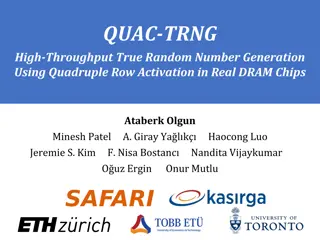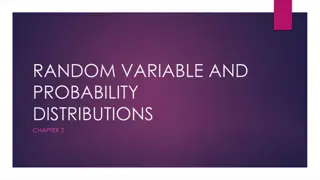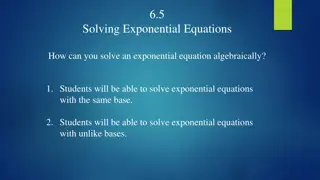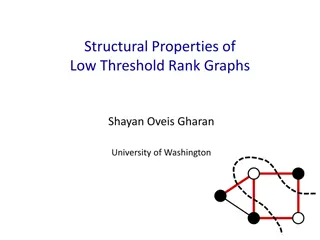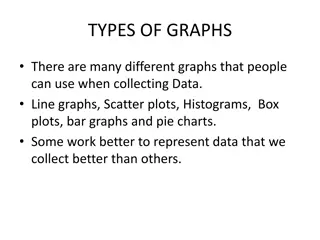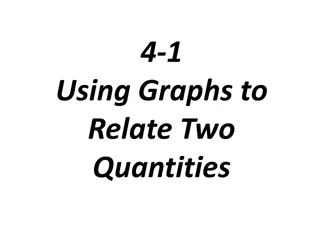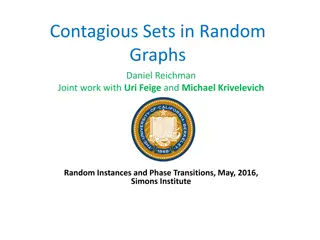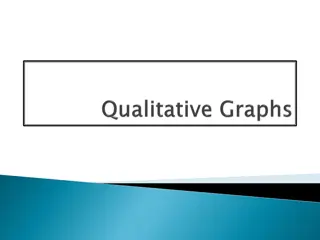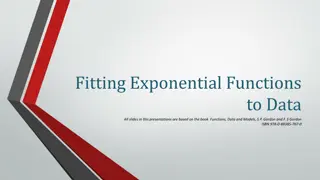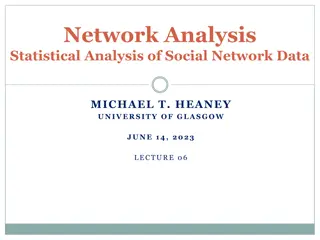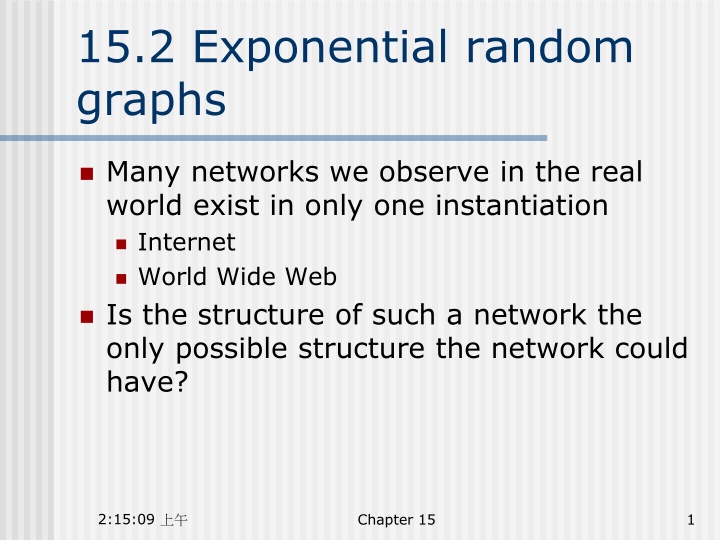
Exponential Random Graphs in Network Structures
Explore the concept of exponential random graphs and their application in analyzing different network structures. Learn about ensemble models of networks, defining probabilities for graphs, maximizing entropy, and the partition function in graph theory. Gain insights into the possibilities and constraints of network representations through a comprehensive study of exponential random graphs.
Download Presentation

Please find below an Image/Link to download the presentation.
The content on the website is provided AS IS for your information and personal use only. It may not be sold, licensed, or shared on other websites without obtaining consent from the author. If you encounter any issues during the download, it is possible that the publisher has removed the file from their server.
You are allowed to download the files provided on this website for personal or commercial use, subject to the condition that they are used lawfully. All files are the property of their respective owners.
The content on the website is provided AS IS for your information and personal use only. It may not be sold, licensed, or shared on other websites without obtaining consent from the author.
E N D
Presentation Transcript
15.2 Exponential random graphs Many networks we observe in the real world exist in only one instantiation Internet World Wide Web Is the structure of such a network the only possible structure the network could have? 2:15:09 Chapter 15 1
In some cases the questions we want to answer about the networked system can be tackled by studying the structure of only a single observed example But there are cases where we would like to know about the entire set of possible networks that could represent a system Considerations of this kind lead us to consider ensemble models of networks 2:15:09 Chapter 15 2
15.2.1 Definition of exponential random graphs Suppose that we have some set of network measures whose numerical values are to be fixed Let the measures be x1, x2, Consider the set G of all simple graphs with n vertices and let us define the ensemble by giving each graph G a probability P(G) such that 2:15:09 Chapter 15 3
The mean measure <xi> is Let us fix the mean value of each measure and ask what probability we need to assign to each graph. The question becomes The number of measures is typically small and the number of graphs is large, if not infinite 2:15:09 Chapter 15 4
Gibbs entropy The best choice of probability distribution is to maximize the Gibbs entropy The maximization of the entropy subject to the constraints on mean network measures can be solved by the method of Lagrange multipliers 2:15:09 Chapter 15 5
The optimum is the set of values of P(G) that maximizes the quantity Differentiating with respect to P(G) we get 2:15:09 Chapter 15 6
Partition function and graph Hamiltonian Z=exp(1- ) is called the partition function H(G) is the graph Hamiltonian 2:15:09 Chapter 15 7
It remains to find the values of Z and i Z is determined by the normalization condition, which requires that Thus, The determination of iis problem dependent 2:15:09 Chapter 15 8
15.2.2 Expectation Values Once we have determined P(G), we can calculate quantities of interest within the ensemble The expectation of quantity y in the ensemble is This calculation gives us a best estimate of the value of y For instance, fixed the mean degree of the network, the methodology gives the best estimate of the degree distribution 2:15:09 Chapter 15 9
A special case is that y itself one of the set of network measures xithat we have used to specify the ensemble Why doing this? The answer is that we still need to fix the parameters iand we do this by specifying the mean value <xi> The quantity F=ln(Z) is called the free energy of the ensemble and 2:15:09 Chapter 15 10
For general case, the trick is to introduce an extra term involving y into the Hamiltonian: We now differentiate with respect to (at the point = ) to calculate the mean value of y 2:15:09 Chapter 15 11
Some examples G(n,m) random graphs Configuration models Reciprocity models Two-star models Strauss s model of transitive networks 2:15:09 Chapter 15 12
15.2.3 Simple examples G(n,m) random graphs Configuration models 2:15:09 Chapter 15 13
The simplest example is the model in which we fix the expected number of edges in an undirected network only Hamiltonian H= m, where m is the number of edges The ensemble probability and the partition function A standard way to perform sum over graphs G is to sum over possible values of the elements Aijof the adjacency matrix 2:15:09 Chapter 15 14
The number of edges in terms of the elements of the adjacency matrix The partition function is The free energy is 2:15:09 Chapter 15 15
From , the average number of edges To achieve a desired value of <m>, the value of should be Let pvwbe the probability that there is an edge between vertex v and vertex w pvwis the mean of Avw 2:15:09 Chapter 15 16
The probability of an edge between two vertices is uniform for all pairs of vertices This model is just the ordinary Poisson random graph with 2:15:09 Chapter 15 17
In the second example, we create a model with specified expected degree of each vertex within the ensemble The graph Hamiltonian Degrees in terms of the adjacency matrix 2:15:09 Chapter 15 18
The Hamiltonian in terms of the adjacency matrix The partition function 2:15:09 Chapter 15 19
Probability of an edge between vertex v and vertex w is This probability is now dependent on vertices v and w In a sparse network, pvwis much smaller than 1, which implies 2:15:09 Chapter 15 20
The average degree is Thus, where Thus, Since we require that thus, This is the configuration model discussed in Chapter 13 2:15:09 Chapter 15 21
15.2.4 Reciprocity model In a directed network, if there is a directed edge from vertex u to vertex v and there is also an edge from vertex v to vertex u, we say the edge from u to v is reciprocated The reciprocity r is defined as the fraction of edges that are reciprocated We create an exponential random graph model by fixing the expected number of reciprocated edges 2:15:09 Chapter 15 22
The number of reciprocated edges mris We fix the number of edges and the number of reciprocated edges The partition function 2:15:09 Chapter 15 23
The free energy The expected degrees The reciprocity 2:15:09 Chapter 15 24
15.2.5 Two-star model In this model, we specify the expected number <m> of edges in the network and the expected number <m2> of two- stars (or connected triples) The two-star model allows us to control the clumpiness of the network, the extent to which the edges gather together in clumps 2:15:09 Chapter 15 25
The Hamiltonian 2:15:09 Chapter 15 26
Mean-field theory Mean-field theory is a technique developed in statistical physics Mean-field theory replaces state variables in the system dynamic equations by their corresponding mean values Replace the entries of the adjacency matrix in the Hamiltonian by their corresponding mean values 2:15:09 Chapter 15 27
The Hamiltonian 2:15:09 Chapter 15 28
This is the same Hamiltonian for the ordinary Poisson graph with replaced by +2 np We can reuse the partition function and other quantities of the previous section The average number of edges is The average number of edges is linked to the edge probability by and thus 2:15:09 Chapter 15 29
Let us define B=/2 and C=n/2 and we have There is no close-form solution for the above equation However, one can study the structure of the solution using a graphical method 2:15:09 Chapter 15 30
Plot of y=p and C=1/2 and three values of B Varying B simply shifts the curve horizontally without changing its shape 2:15:09 Chapter 15 31
As B is varied the intersection with y=p moves smoothly between high and low values of p Thus, in this regime we can tune the density of the network to any desired value by varying the parameter B 2:15:09 Chapter 15 32
C=3/2 and three values of B It is possible for suitable values of B that the curve has three intersections with y=p 2:15:09 Chapter 15 33
Spontaneous symmetry breaking The middle solution is unphysical and only the two outer solutions are realized in practice These two correspond to very different networks One has very high density while the other is very sparse If one were to simulate the two-star model, one would in this regime sometimes find a high-density network and sometimes a sparse network One would not be able to predict which would occur This peculiar behavior is called spontaneous symmetry breaking Condensed matter physics and particle physics 2:15:09 Chapter 15 34
2:15:09 Chapter 15 35
Critical point Continuous phase transition: Below a critical point, there is no symmetry breaking C=1 2:15:09 Chapter 15 36
Note that even when we are above the critical point, spontaneous symmetry breaking still only occurs within a certain range of B If B is either too small or too large, there is only one solution The portion of parameter space for B where there are two solutions is called the coexistence region 2:15:09 Chapter 15 37
The boundaries of the coexistence region correspond to the values of B such that the curve is tangent to the line y=p 2:15:09 Chapter 15 38
The gradient of is Setting this to one and using sech2x=1- tanh2x, we have But, p satisfies , so 2:15:09 Chapter 15 39
2:15:09 Chapter 15 40
15.2.6 Strausss model of transitive networks Strauss s model is a simple undirected network that shows clustering or transitivity The number of triangles is Hamiltonian 2:15:09 Chapter 15 41
Strausss model can be solved by using a mean-field technique There is a phase transition beyond which the system develops a coexistence region where there are two distinct solutions to the equations Both are realized in simulations One solution corresponds to high density networks and the other a network of low density There is in this regime no choice of model parameters that will give networks of medium density 2:15:09 Chapter 15 42






